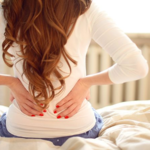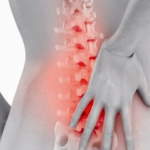How is an inguinal hernia diagnosed and treated in women
Many people mistakenly believe that an inguinal hernia is a disease that only develops in males. However, if you talk to a doctor, he will refute this opinion, saying that inguinal hernia in women is also diagnosed quite often.
Let us consider in more detail how to determine the disease, what to do to prevent its development, whether it can pose a danger to the patient.
What is this disease
What is an inguinal hernia? This is a pathological protrusion of tissues into the inguinal canal, which normally withstands pressure from the internal organs from the outside. If for some reason the pressure ceases to be restrained by the tissues, the contents of the abdominal cavity appear in the lumen of the canal. Basically, they find the small intestine or omentum there, but in some cases you can also find part of the large intestine, the uterus and its tubes, and the spleen.
In exceptional cases, the protrusion will interfere with the stomach and gallbladder.
It is believed that in women the inguinal canal is much better protected from the formation of hernias than in males. This is explained by the fact that in boys, the testicles in the process of development make their way from the abdominal cavity to the scrotum, leaving behind a vulnerable space. This doesn't happen with girls. In this regard, it is far from always easy to determine the presence of pathology.
The peak of hernia formation usually falls on two age intervals. First, girls from 1 to 2 years old are at risk, and then mature women from 40 years and older.
Doctors say that in children the disease mainly has hereditary prerequisites and turns out to be congenital, but in adults its development is a consequence of exposure to traumatic factors.
Reasons for the development of pathology
The development of a hernia in the groin in women can be due to the influence of a huge number of factors. First of all, the causes that directly affect the development of the disease are distinguished.
These include:
- lack of physical activity and the habit of leading a sedentary lifestyle;
- insufficiency of the ligamentous-muscular apparatus due to congenital defects;
- hereditary predisposition;
- the presence of excess weight;
- initially weak physique.
In addition to the immediate causes, a number of predisposing factors are additionally distinguished that do not lead to the formation of pathology, but significantly increase the likelihood of its development.
These include:
- constant crying of the baby;
- severe bouts of coughing or sneezing, which can be triggered by allergies or a cold;
- problems with the process of urination due to diseases of the genitourinary system;
- unbearable loads of a physical type;
- frequent bouts of vomiting;
- childbirth with complications.
Disease classification
The disease is divided by doctors into three main varieties, depending on the direction in which the pathological protrusion occurs in the inguinal canal.
Allocate hernias:
- oblique, in which the content exits through the external inguinal fossa (most often diagnosed);
- straight lines, in which the protrusion prolapses through the internal fossa;
- external supravesical, in which the protrusion occurs through the fossa of the same name.
Another criterion determined by doctors is the rightness or lack of it.
If the hernia is reducible, then its disappearance can be achieved if you simply lie down or lightly press on the protrusion with your hands. Otherwise, the introduction of tissues back into the abdominal cavity is impossible, the hernial sac is always in an unchanged state.
Symptoms
Signs of an inguinal hernia in women are not always clearly recognizable, but in most cases, a doctor's assessment of symptoms is enough to make a correct diagnosis.
You can recognize it by focusing on:
- pain syndrome that develops in a strictly defined place (pain will be felt from the side from which the protrusion has formed, while it can be both acute and dull);
- increased pain in response to tension in the press (during coughing, sneezing, when trying to lift heavy objects);
- various pathologies in the work of the digestive tract (most often women complain of stool disorders, attacks of flatulence, heartburn, vomiting).
Symptoms are often blurred, especially if the protrusion is not large. It is interesting that if the hernia hurts more intensely during the menstrual period, then the organs of the reproductive system were also in the hernial sac.
In severe cases, a woman may additionally complain of redness and severe soreness of the pathological area, attacks of weakness and dizziness, tachycardia.
Diagnostic methods
A reliable diagnosis of the fair sex can only be made in stationary conditions. At the first stage, the doctor talks with the patient, specifying what are the features of the pain symptom, how often her digestive tract hurts, and whether self-reduction of the protrusion is possible. Additionally, an examination is carried out using the palpation technique in order to obtain more detailed information about the localization of the pathology and its other features.
If the protrusion is very slight, it is possible to conduct a test with the tension of the press in order to obtain objective data on how it looks. To do this, the woman is laid on the couch, fingers are placed in the area of the alleged defect and asked to tighten the press. Under the fingers, the doctor will feel the desired hernia, which will be able to probe and evaluate.
Additionally, a girl or woman suffering from a disease must undergo an ultrasound diagnosis. Using this method, it is possible to clarify the size of the defect, the features of its position, and obtain data on which organs were in the bag. Ultrasound may be accompanied by barium enema, in which a special contrast agent is injected into the small intestine for better visualization.
Treatment approaches
How to treat an inguinal hernia in women? Today, there are two main methods: conservative and operational. Moreover, conservative methods are used only at the stage of preparation for surgery, since only surgery is an effective method of getting rid of the disease. Folk recipes, which can be found in large quantities on the Internet, as “useful” and “healing” also do not work, since they are not able to eliminate the cause of the disease, but only fight its symptoms.
conservative
Conservative treatment is used for a short time at the stage of preparing the patient for surgery. It is important to remember that without surgery a complete cure is impossible, and if you try to get rid of the pathology without surgery, you can lose valuable time and face complications.
In the preoperative period, to stabilize the woman's condition, it is recommended:
- wearing a special bandage (it will allow you to keep the protrusion, preventing it from increasing due to daily stress);
- performing light physical exercises under the supervision of a doctor (exercise therapy will allow you to strengthen a little the muscular frame in the defect zone, which will allow you to avoid relapse in the future);
- the use of various compresses (mainly aimed at reducing the intensity of the pain symptom and eliminating inflammation);
- the use of medicines (as in the case of compresses, the main task of medicines is to eliminate pain and inflammation).
Operational
There are three main types of inguinal hernia surgery:
- Tension hernioplasty.
The oldest and simplest method, which is rarely used today. The bottom line is to tighten the tissue in the area of the hernial gate and stitch it together. Great risk of relapse.
- Tension-free hernioplasty.
In this case, it is possible to correct the defect not by suturing the tissues, but by inserting a small mesh implant. The implant holds the hernia in place, but does not stretch, which helps to avoid recurrences.
There are two ways to install the mesh insert. In the first case, open access to the damage is used, and in the second, laparoscopic. Today, in Russian and foreign clinics, preference is given to the second method, since it is less traumatic and reduces the patient's recovery period after surgery.
- Extra-abdominal endoscopic hernioplasty
In fact, this is the same tension-free hernioplasty, but in this case, the restraining implant is placed not in the abdominal cavity, but almost immediately under the skin. The operation is difficult in terms of execution, but differs in that it does not form adhesions in the abdominal cavity.
Any of the operations, due to the peculiarities of the anatomical development of a woman, is not difficult, and therefore any complications are very rare. Postoperative relapses are also rare.
Possible complications of the disease
Why is an inguinal hernia dangerous? After all, doctors recommend surgical intervention not only because of the aesthetic defect, but also because of the risk of complications of the disease.
These include:
- Inflammation
The inflammatory process in the hernial sac, although rare, cannot exclude the possibility of its development. The appendix is most often involved in the pathological process, but the intestines or female genital organs can also become causes.
Often, inflammation manifests itself with minimal symptoms, the main of which is a jump in body temperature, but a bright clinical caritna is also possible, for example, with appendicitis.
- blockage.
If the loops of the large intestine get into the hernial sac, there is a high risk of blockage with feces that will not be fully excreted. In addition to stool disorders in this case, intoxication, fever, nausea and vomiting are noted. In advanced cases, even necrosis of the intestinal area in which the blockage occurred is possible.
- infringement.
Infringement is one of the most dangerous and common complications. It is characterized by pinching of organs and tissues in the hernial orifice, which can lead to blockage of blood flow and their subsequent death. In case of infringement, the patient needs urgent help from medical workers, the operation is carried out without delay.
Prevention approaches
Inguinal hernia in women is easily preventable.
Recommended:
- make time for small daily physical activity that will help maintain the overall tone of the body;
- eat right, monitor weight and prevent the development of obesity;
- protect the groin area from traumatic effects;
- carefully dose hard physical labor, especially if there is a hereditary predisposition to the development of pathology;
- contacting a doctor when the first suspicious symptoms of the disease appear.
Inguinal hernia is a common disease that is treated only with the help of surgery.
The use of conservative methods and traditional medicine can only be used as a preliminary preparation before the intervention.
The female body in most cases easily tolerates surgery for the disease. Cases of complications or relapses are extremely rare. In this regard, patients are not recommended to delay the operation. The sooner the pathology is eliminated, the better.










